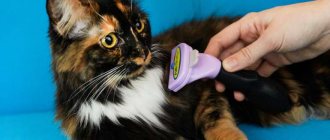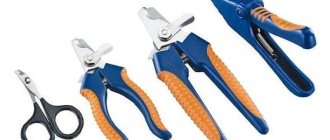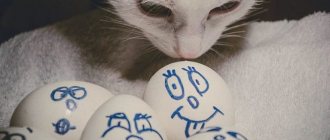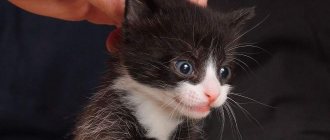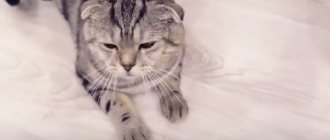How to trim cat hair
Grooming is very popular today. Salons are popping up, often specializing in the feline family. They are serviced by mobile technicians at home. Let's consider options for performing this procedure and find out how to trim a cat yourself, using a different set of tools, techniques and techniques.
Depending on the breed of cat, the thickness and amount of fur varies greatly. In accordance with this factor, choose the most suitable cutting tool:
- scissors, preferably with curved tips, for safety;
- hair clipper - preferably for animals, but you can also use a regular clipper for people.
How does a cat feel about haircuts?
Trimming the hair on cats often makes grooming much easier for the pet owner and reduces house cleaning time. At the same time, the pet himself never expresses pleasure from this procedure.
It is always stressful to one degree or another. For some individuals it is stronger, at the limit of their capabilities, while others tolerate it more easily. But almost all cats love brushing and even often fall asleep during this procedure if it is carried out carefully and with love.
The Dragon
Therefore, it is advisable to make a decision about the need for a haircut, taking into account the pet’s personal qualities, and if the procedure cannot be refused, and the cat is very nervous, give him sedative drops and involve several people to help.
The process of cutting a cat with scissors
To groom a cat at home, it is important to have someone help hold it for the first time. The cat is placed on its side and its limbs are supported. You can use a plastic collar for safety.
Before the procedure, it is important to disinfect the instrument with alcohol so as not to infect the animal in case of injury.
Using scissors, you should immediately cut off tangles and any areas of matted fur. Then proceed directly to the haircut:
- The head is treated. Usually the head is not cut bald, leaving a fluffy hairstyle, but it is better to immediately trim off the excess overgrown strands and hair. It is important not to touch the whiskers, but it is better to remove the “whiskers” - it will be easier for the pet to eat and keep clean.
- Remove excess volume from the body, neck and behind the ears, paws and tail.
- Pay special attention to the intimate area; it is important not to damage these areas with scissors.
After finishing, you should wash the cat and dry it thoroughly with a hairdryer, removing excess hair.
Grooming aggressive cats
To groom aggressive cats, it is recommended to use special collars.
Very often, cats behave aggressively during grooming. In such cases, the following recommendations may help:
- Using a plastic collar. Such devices can be purchased at a veterinary clinic or pet store. Before the procedure, it is placed around the animal’s neck and secures its head. In this position, the cat simply will not be able to bite. It is imperative to hold your paws.
- Stationery clip. An ordinary stationery paper clip, which is placed on the scruff of the neck, can calm an unruly pet before a haircut.
- Hair trimming. When using this technique, the fur will remain longer, but the animal itself will behave more docile. This is due to the fact that cutting against the grain irritates the pet, contributing to the appearance of unnecessary aggression.
- Assistant. Grooming a rambunctious cat is much easier and faster with a helper to hold him.
- Use of sedatives and sleeping pills. Overly active pets are sometimes given herbal-based sedatives or sleeping pills. To avoid harm to the cat, the use of such medications should only be carried out under the supervision of a veterinarian.
- Anesthesia. The use of anesthesia to subdue an animal during a haircut is unjustified and can cause irreparable harm to the health and life of the pet. It is carried out only in the most extreme cases and no more than 2 times a year. Before a cat is euthanized to be clipped, she needs to undergo a full examination in order to eliminate all possible risks of complications.
How to cut a cat's hair with a clipper
The cat clipper should be turned on in advance so that the pet gets used to its sound and is not afraid. In the same way, the cat is cut with a clipper, starting from the sides. The back and stomach are treated, especially carefully trimming the nipple area.
The clipper can cut hair according to its height and against it, using a nozzle of at least 3 mm. If there are lumps and tangles, they should be removed in advance, as the device will not cope with them.
The skin needs to be stretched - this will avoid cuts from the blade. Carefully trim around the intimate area.
At the very end of the work, it is better to cut off the wool with scissors, since contact of the machine with the skin can cause wounds and microscopic scratches. After grooming, the cat must be bathed with shampoo to remove any remaining hair and dirt. Dry with a hairdryer and towel.
Cat grooming
Grooming salons provide care services for cats, dogs and other pets. This place is popular for pet owners who participate in exhibitions. After all, appearance at such events is very important.
An animal can also be trimmed for hygienic purposes: if the cat lacks vitamins and has developed dermatological problems, or if the long-haired pet has mats.
Professional grooming in a salon or at home is carried out by a master using such tools
:
- Device for safely cutting tangles;
- Massage brushes for haircuts;
- Combs;
- Hairdryers;
- Special machines for grooming;
- Slicker brushes for cats;
- Stripping and thinning scissors;
- Nail clippers;
- Rake for combing wool.
Trimming a cat's fur at a salon can sometimes be difficult due to his rambunctious nature. In an unfamiliar environment, a stranger can cause serious stress to your animal. Therefore, grooming services are also provided at home.
Secrets of grooming at home
The owner of the cat can cut it himself, or at any time contact a specialized salon for a professional grooming of the animal. However, this opportunity is often not possible due to the lack of a salon in the city. Grooming includes not only cat grooming, but also comprehensive care in general, which includes the following procedures:
- trim claws;
- comb out tangles from wool, untangle matted areas;
- ear cleaning;
- eye wash;
- trimming hair between the toes, on the paws;
- removal of tartar and formations, cleaning of the oral cavity;
- cleaning of the excretory glands and other services.
The word “grooming” itself comes from hippology – the science of horses. A groom was a professional groom who looked after horses. Today this is the name given to specialists who care for any animal.
Additional tools
For a high-quality and efficient grooming of cats, you will need not only a tool for trimming hair (clipper or scissors), but also several additional things:
- comb-comb for preliminary and subsequent separation of strands;
- special attachments for the clipper - if the hair is long, the attachments must be at least 3 mm long, it is better to take veterinary ones;
- simple hairdressing scissors (regular or thinning);
- a product for disinfecting fur and skin - sudden movements of your pet are possible, which often leads to cuts and injuries. To prevent infections and inflammations, it is important to immediately treat the damaged area;
- a special high table or ironing board on which it will be convenient and safe to work on the cat’s hair;
- hydrogen peroxide, cotton wool to disinfect possible cuts;
- animal food.
It is worth feeding the cat in advance so that it calms down a little, and also giving treats during the grooming procedure.
During the work, it is important to create a soft, calm, harmonious environment - after all, you are dealing with cutting tools. Cats need to feel calm. Movements with the machine should be smooth and calm.
A good solution is to attract a partner who will hold and pet the cat. It is also important not to tease the cat if it is angry, not to involve it in games or irritate it with distractions.
Aggressive cat
What to do if the cat behaves aggressively, does not allow itself to be cut, twitches and is nervous? There are several options:
- choose another date for a haircut, when the “restless” days or fear of the tool have passed;
- give the cat a sedative if it is not given - inhibition of the nervous system and general relaxation after taking the medicine will simplify the solution to the problem and reduce aggression.
An experienced professional grooms cats using his own methods of handling animals, so in extreme cases there is always the option of calling a specialist.
Haircut in several passes, with breaks
Sometimes it is necessary to do the haircut in several stages if it is not possible to reduce the length of the coat at one time. You can take the cat during the day to continue grooming, this way it will even more quickly adapt to the unusual actions of its owners and allow itself to be trimmed faster.
This option is optimal in the case of a very active and curious kitten who does not like to sit still for a long time and needs to be calmed.
If you still haven’t found an effective way to trim your cat’s hair at home, you can simply leave it with its existing coat. Then you will have to constantly collect lost hair and fight fleas.
The need for cat grooming - pros and cons
Most often, the need to groom a cat is due to the numerous tangles that have formed on the animal’s body due to lack of proper care. There are stories when tramps picked up from the street were found to have numerous ulcers, sores, worm eggs, external parasites and their larvae under matted hair.
In the case of weeping ulcers and lichen, the pet must be frequently treated with medicinal ointments and compositions, and it can be difficult to reach the skin through the hair.
In addition, with abundant tangles, the cat’s skin tightens, and the animal experiences unpleasant and even painful sensations. Sometimes it becomes necessary to trim your pet due to too many hairballs forming in the gastrointestinal tract, which can cause serious diseases of the digestive system.
Another common argument from owners in favor of this procedure is that the climate is too hot. Constant temperatures above +35 °C are usually difficult for animals to tolerate.
We recommend reading the article about grooming cats.
Often in breeds with special coats, the hair around the anus and genitals becomes very dirty when using the litter box. Of course, you can often wash your pet or trim problem areas, but the aesthetics of the appearance suffer. Read the article about long-haired breeds.
Sometimes you have to resort to cutting due to heavy shedding, when the whole house is littered with hairballs. This is especially true if there are small children or people with allergies in the apartment. But as a rule, the seasonal change of coat passes quickly, and in other cases you should be concerned about the health of the animal and consult a veterinarian. Severe hair loss in a cat can be caused by a lack or excess of vitamins in the diet, or some other pathologies.
Sometimes owners of older animals groom their cats because it is difficult for them to care for their fur themselves.
Many owners prefer aesthetic rather than hygienic haircuts, which give their pet a well-groomed and even glamorous look. Thus, the benefits of grooming cats in many cases are undeniable; grooming often transforms the most homely pet.
In any case, before deciding to groom a cat, the owner should also think about the negative side:
- To one degree or another, the thermoregulation of the cat’s body is necessarily disrupted, because the skin’s natural breathing process is rudely interfered with.
- Some experts believe that cat hair that grows back after being trimmed is of poorer quality.
- These animals usually do not tolerate the procedure itself well and often become depressed and fall ill. There are even isolated cases of a pet dying during a haircut due to heart failure. Read about stress in cats.
- After removing the fur with a clipper or scissors, the cat's hair, as a rule, grows back very slowly and does not always return to its previous length.
- In the first days after cutting, the hairs are very prickly and cause inconvenience to both the animal and the person.
In principle, if the animal is healthy, then it does not need a haircut under any circumstances. Cats groom themselves very often, almost constantly, which provides excellent coat care. Regular brushing will also help. Read the article about how to comb cats and kittens correctly.
When licking, cats realize many instincts - they evenly distribute and lick their own scent, calm down, and relieve stress.
The condition of the skin and coat are the main signs of a pet’s health. At the first symptoms of dull hair, the owner should reconsider the cat’s diet and not grab the scissors.
It must be remembered that grooming a cat is not the norm, it is a radical measure, permissible in case of urgent need - skin diseases and abundant mats. In all other cases, this procedure is not mandatory.
If the cat is injured
If it was not possible to avoid injury from scissors or clippers when grooming a cat, immediate measures must be taken to eliminate the consequences:
- wipe the cut area with a disinfectant;
- apply healing ointment with a bandage or plaster; it is better to use a bandage so that the pad does not fall off when moving.
In case of deep and lacerated wounds, surgical intervention is required - it is better to take the cat to the veterinarian or call a doctor at home. Eye damage is especially dangerous; in this situation, consult a doctor immediately.
What to do if you accidentally hurt your cat?
Sometimes even the most careful actions can lead to injury. What to do if the cat is still injured? You should have iodine or hydrogen peroxide with cotton swabs on hand. Apply a small amount of antiseptic solution to cotton wool and gently rub the skin around the cut to stop bleeding, you can press a dry cotton swab against the wound for a few minutes.
Please note: in such an unpleasant situation, you should not panic. It is advisable to calm the animal by telling it in a quiet voice the kind words that you are used to saying in a normal situation. While grooming, you should under no circumstances raise your voice to the cat or speak in a raised voice with your partner, make sudden movements, and especially not use physical force (we are talking about hitting, pinching and other actions).
Thus, grooming a cat at home using clippers and scissors is, first of all, a hygienic event aimed at maintaining a neat appearance of the pet. If you are going to prepare your cat for a show or other important event, it is recommended to schedule a decorative haircut with a professional groomer. In clinics, decorative haircuts for cats are done using light anesthesia or sedatives. However, it should be remembered that constant exposure to such medications can adversely affect the health of your pet.
Cat hairstyle trends: which haircut to choose?
If you just need to shorten the coat, this is a simple task. But there is a choice of different curly haircuts, which are chosen taking into account the type of coat, thickness, and breed of the animal. This is a very important factor for winning at the exhibition, because it provides the original appearance of the pet and reflects its individuality.
The following hairstyle options are relevant today:
- “lion”: the entire back and the upper side of the legs are cut, the tail at the base. At the same time, the head is left untouched, as is the neck - a kind of “mane” is formed, as is the tassel at the tip of the tail. The tail can be shaped like a pom-pom, Christmas tree, or panicle. You can achieve the squirrel tail effect. The “socks” on the feet are made short or in the form of “gloves”.
- “puma”: performed similarly to “lion”, but the shirtfront is left in the chest area, which looks beautiful;
- “dragon”: cut the sides and belly until smooth, leave the fur along the ridge and tail, give it the shape of a fluffy comb with incisors;
- “Puss in Boots”: repeating the image of a fairy-tale hero, the hair on the back is cut short, the paws are cut off from above, so that there are neat and identical “boots” below.
There are other models of hairstyles, but they are more complex to perform; it is better to entrust them to groomers. This is the so-called “continental” haircut, “modern”, “harlequin”.
We hope that this guide will help you successfully and tastefully decorate your favorite cat's fur. By following all the above recommendations, you will know exactly how to successfully trim a cat with a clipper at home and create an aesthetically pleasing appearance for your pet.
Which machine is recommended to choose for grooming a cat?
Currently, the choice of professional tools for grooming furry pets is huge: some owners are trying to save money and purchase the cheapest option. This is their mistake: an inexpensive trimmer will painfully pull out hairs or burn delicate skin, in addition, such models quickly become unusable.
If you need to remove hairs in hard-to-reach places, it is recommended to choose a small trimmer whose blades do not exceed two centimeters in length. Such devices are designed to treat the muzzle and ears; they can be used to remove excess hair under the tail. This is an auxiliary tool that is needed for a thorough haircut, for example, before exhibition events.
For thicker coats, a powerful machine with wide blades is suitable, which can remove even balls of matted fur from Persians. At the same time, it is important that the manufacturer carefully sharpens the blades, otherwise after each manipulation the machine will have to be returned to the master.
The power of the device for Persian breeds should be 45 W or more. Machines with less power simply will not cope with thick hair; they will overheat and break during the first procedure. If your animal has short hair, you can get by with the 20 W model.
It is recommended to purchase an option with the ability to automatically adjust the blades without the need to replace them. In this case, the minimum length of the blades is 0.5 mm (which means that after cutting with such a clipper, the length of the animal’s hair will be approximately 0.5 centimeters). Buying products with small blades is dangerous, because at home, without sufficient experience, you can simply injure the animal.
The best option is a machine that runs on electricity, since the batteries run out quickly, especially when working for a long time with breaks (for example, if you are distracted by conversations and calming actions).
Don’t forget that the trimmer should be as silent as possible (you can check this when purchasing by comparing the performance of several models), and also fit comfortably in your hand. You should not choose devices made of too slippery and heavy material, in which case you will not be able to carry out a quality haircut.
Before purchasing, turn the device on and off several times: during operation, it should not get very hot, otherwise you will have to constantly take breaks, and this is not very convenient.
Do you need to cut your cat's hair?
Many owners are concerned about whether their cat needs to be cut at all? We are used to dogs being cut, but we usually see cat haircuts only in collections of funny pictures. Let's figure out what reasons encourage owners to cut their pets' hair.
Most often, cat grooming at home is carried out before the onset of shedding. During this period, fallen fur spreads literally throughout the house, gets clogged up in carpets and furniture, and floats in the air. A haircut will make it easier not only to clean the house, but also to care for your cat - it will be much easier to comb it, and the fur will stop getting tangled and matted. In hot weather, a haircut improves heat exchange and improves the well-being of a fluffy cat.
Every day the cat takes care of its coat and licks itself. The shed hair ends up in the cat's stomach, and the cat usually regurgitates the accumulated hair. In some cases, a hairball can lead to an intestinal obstruction and require complex treatment. It is for these and other reasons that owners are increasingly deciding to cut their cat's hair.
What you need to know before cutting your cat's hair
There are several things you need to know before cutting your pet's hair. Grooming is not suitable for all cats and can have unexpected consequences.
- The texture of the coat and its color can be permanently changed after clipping.
- There are breeds and colors that should never be cut - cats with tipping and color points. The cat will look completely different after the haircut. The animal's fur will darken, and the cat will forever lose its natural coloring.
- In some cases, the fur takes a very long time to grow and may never reach its previous length.
- The hair on the ears and head cannot be cut, the same goes for the mustache.
- If the cat becomes agitated and struggles, muscle relaxants can be used to limit the cat's mobility and reduce muscle tone.
- Aggressive and violent animals are immobilized using anesthesia. This carries some risk and is not suitable for older animals.
- Sedatives, muscle relaxants and anesthesia can only be prescribed by a veterinarian. You cannot use them on your own at home.
How cats are cut
Before deciding on such an experiment, you need to choose one of two options: a haircut in a specialized salon or trim your pet yourself at home. In the latter case, it is better not to use a straight razor, especially since special tools and machines for such cases predominate on the open market. If you stock up on them in a timely manner, you won’t need to go to the salon. The main secrets of the home procedure are described below:
- Grooming can change the color and structure of a cat's coat, for example, the hair darkens and becomes rough to the touch.
- It is important to know that this session takes a long period of time, and with an inexperienced groomer it lasts 2-3 hours.
- It is strictly forbidden to trim the hair on the animal's head, paw pads, ears, or trim the whiskers. Otherwise, the cat loses its sense of touch.
- To prevent the cat from injuring the hairdresser, it is recommended to trim his claws in advance and give him a sedative before the start of the session.
- You can dry an animal's new haircut with a hairdryer, but for this you use a warm air flow, not a hot one.
When wondering whether it is possible to cut cats, you need to find out what kind of haircuts they can be, which cats are best suited, how much will it cost the owner in a special salon? The following cat hairstyles are available to choose from:
- A lion. This model can be used to cut Persian, Scottish, and Siamese cats. The body is trimmed, and the hair remains only on the head and the tip of the tail, like a real lion.
- Puma. The hairstyle is similar to the “Lion”, but differs in the remaining hair on the chest. Persian, Siberian, and Scottish cats are trimmed using this principle.
- The Dragon. A distinctive feature of this image is the mohawk on the back, which starts from the withers and ends at the tip of the tail.
